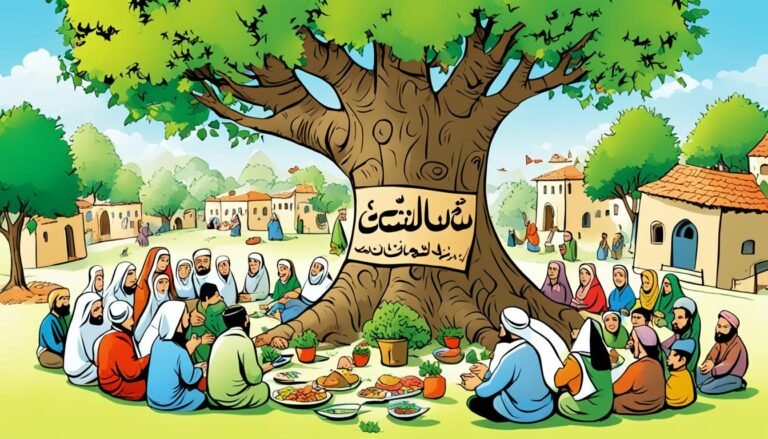The Quest for Authenticity: Modern Critiques of Classical Hadith Collections
What if the core of Islamic teachings, found in classical hadith collections, is more uncertain than we think? Today, new critiques of these collections have sparked intense debates. They question the trustworthiness of hadith. This look aims to uncover how modern scholars are reevaluating these texts. It also highlights their impact on faith and legal views in Islam.
We will explore the history of hadith creation, the doubts about their accuracy, and how new views have changed old beliefs. This topic is crucial. It brings together faith and scholarship in a way that could change how we see Islamic teachings now.
Key Takeaways
- The period of 1860-1880 marked a pivotal moment in modern innovation.
- Islamic modernism has roots in reformist thoughts of the 19th century.
- Modern society is often characterized as a “risk society.”
- Social theorists view modernity as an open, contingent historical process.
- Founding figures of Islamist movements included Jamal al-Din al-Afghani and Muhammad Abduh.
- European colonization instigated significant scholarly engagement with Islamic texts.
- There is a growing emphasis on verifying the reliability of sources concerning the life of Prophet Muhammad.
Introduction to Hadith and Its Significance
Hadith is more than just sayings and actions of the Prophet Muhammad. It’s a key guide for Muslims. It’s as important as the Qur’an in Islamic teachings and law. Together, they guide personal and community life.
Hadith keeps the Prophet’s traditions alive through the years. There are key collections like the Sunni’s Kutub Al-Sittah and the Shia’s Al-Kutub Al-Arb’ah. These texts show how vital hadith is in Islam.
Understanding hadith means knowing how reliable the sayings are. Scholars rate them as sahih (“authentic”), hasan (“good”), or da’if (“weak”). This helps decide if they can guide us.
Some say the Qur’an is enough for law, but most accept hadith too. The way scholars check hadith shows its value. These texts help us live by Islamic values in our daily lives.
Historical Context of Hadith Collection
After Muhammad’s death in 632 CE, the need to preserve his teachings sparked a complex evolution. Scholars debated the value of hadith for ethics and law. They wondered if these stories were important for guiding Muslims.
By the 10th century CE, key texts like Sahih al-Bukhari and Sahih Muslim became well-known. These books laid the groundwork for the hadith we use today.
In the 12th century CE, the Six-Book canon, or Kutub Al-Sittah, became a standard. It included famous works like Sahih al-Bukhari and Sunan Abi Dawud. The Four-Book canon also emerged, with texts like Kitab al-Kafi for Shia Muslims.
Scholars were very careful when checking hadith. They looked for reliable sources and the character of those sharing the stories. For example, Muhammad al-Bukhari checked over 600,000 stories before picking about 7,400 for his book.
Not everyone agreed with the importance of hadith. Some groups, like the Kharijites and Mu’tazilites, preferred to focus only on the Quran. This debate still affects how we understand hadith today.
Classical Hadith Collections Overview
Studying classical hadith collections is key to understanding Islamic teachings and traditions. The Kutub al-Sittah, or “The Six Books,” is the most respected collection of authentic hadith. Works like Sahih al-Bukhari and Sahih Muslim are seen as the most reliable and accurate in the vast hadith universe.
Early scholars worked hard to gather and record the Prophet Muhammad’s teachings. Figures like Imam al-Bukhari and Imam Muslim used strict methods to collect and organize hadiths. They set standards for checking the isnād, the chain of narrators, to make sure the sources were trustworthy.
As Islamic knowledge grew, different groups looked at these hadith collections in their own ways. Sunni Muslims see these texts as key to their beliefs. Shiʿa scholars focus on narrators linked to the Prophet’s family, which shapes their views on hadith interpretation and religious practices.
| Collection | Compiler | Content Focus | Notable Features |
|---|---|---|---|
| Sahih al-Bukhari | Imam al-Bukhari | Authentic hadiths | First comprehensive hadith collection, high reliability |
| Sahih Muslim | Imam Muslim | Authentic hadiths | Respected for meticulous authentication process |
| Sunan Abi Dawood | Abu Dawood | Legal rulings and practices | Concentration on legal hadiths |
| Jami` at-Tirmidhi | Imam al-Tirmidhi | Various topics | Includes grading of hadith authenticity |
| Sunan an-Nasa’i | Imam an-Nasa’i | Legal verdicts | Arabic praise for its precision |
| Sunan Ibn Majah | Imam Ibn Majah | Diverse subjects | Least cited among the Kutub al-Sittah |
The classical hadith collections show the early Islamic community’s effort to keep the Prophet’s words and actions alive. Scholars have passed down these teachings through generations, creating a deep well of Islamic knowledge. These collections offer insights into the diverse beliefs and practices of Muslims today.
Challenges to Hadith Authenticity
Exploring the challenges to hadith authenticity means looking at both past and present views. Early Islamic scholars had big questions about the trustworthiness of hadith stories. They worried about how these stories were passed down and if they could be changed or made up. These early doubts set the stage for ongoing debates about the trustworthiness of hadith collections.
Critiques from Early Islamic Scholars
When hadith literature was first being written down, some scholars doubted the accuracy of these stories. They questioned how hadith were shared, looked for biases, and wondered about their original context. They showed that just because a hadith was mentioned didn’t mean it was true.
Modern Concerns about Oral Transmission
Today, the trustworthiness of passing down stories by mouth is a big topic of discussion. Scholars in the 19th and 20th centuries worried that stories could change a lot over time. With hadith collections being written down 220 to 270 years after the Prophet’s death, there’s a lot of doubt about their accuracy. These doubts add to the ongoing debate on the challenges hadith face today.
Modern Assessment of Hadith Collections
Today, we look at hadith collections with new methods. Scholars use a two-step approach. They check the chain of who passed down the saying (isnad) and the saying itself (matn). This helps us understand if a hadith is true, considering when it was said and how it got to us.
Experts now say we must look at the context too. This new view changes how we study methodology in hadith studies. By looking at why people shared these sayings and the time they lived in, we learn more about their truth.
Over the last few decades, scholars have dug deep into the past. They’ve studied criticisms from the ninth century C.E. Works by al-Bukhārī and Muslim ibn al-Ḥajjāj set the bar high for today’s checks. These efforts help us get closer to the real teachings of Islam, showing how important hadith is.
| Methodology Component | Description |
|---|---|
| Isnad | Examination of the chain of narrators to establish authenticity. |
| Matn | Analysis of the text for consistency and contextual relevance. |
| Contextual Analysis | Understanding the historical and cultural backdrop of hadith transmission. |
| Comparative Studies | Evaluating hadith across various collections for discrepancies and agreements. |
| Scholarly Consensus | Consensus among scholars on the authenticity levels of hadith. |
The Quest for Authenticity: Modern Critiques of Classical Hadith Collections
Scholars today are using new ways to check the trustworthiness of old hadith texts. They aim to make these texts more reliable and true. We will look into these new methods and check how trustworthy the old texts are by analyzing their isnad and matn.
Contemporary Methods in Hadith Criticism
Now, scholars use a mix of history, text analysis, and social studies to study hadith. This helps them question the realness of hadith. They look at the social and political settings when hadith were shared. This shows how culture affected how they were passed down.
Assessing Authenticity Through Isnad and Matn Analysis
Checking hadith is all about looking at the isnad and matn. The isnad is the chain of people who shared the hadith. The matn is the actual words of the hadith. Scholars like al-Bukhari and Muslim worked hard to gather these texts. But, today, people are finding problems with their methods.
For instance, al-Bukhari has about 7,275 hadith, but around 89 of them have issues. Muslim’s collection also has about 100 hadith with problems. This shows we need to keep checking these texts with new methods.
| Collection | Total Hadith | Problematic Hadith | Questioned Transmitters |
|---|---|---|---|
| al-Bukhari | 7,275 | 89 | 80 |
| Muslim | 4,000 | 100 | 160 |
Impact of Modern Critiques on Hadith Scholarship
Modern critiques are changing how scholars view hadith. They make scholars think harder about the old texts. With 1.8 billion Muslims looking up to Prophet Muhammad’s teachings, scholars are updating their ways.
Before, they mainly used Sahih Bukhari and Sahih Muslim for reliable hadith. Now, they face new challenges in checking the hadith’s history. This shows a big change in how they study hadith, as they aim for more accuracy in today’s debates.
There are about 12 to 15 key sciences of Arabic that help understand Islamic texts. This knowledge makes their discussions richer, blending old and new ideas. Scholars like Ibn al-Qayyim and Imam al-Bukhari show the value of mixing old knowledge with new methods.
There are around 25 important sources in hadith studies, showing how deep scholars dive into this topic. Scholars like al-Qāḍī ʿIyāḍ and their work show how modern views are changing scholarship. This change highlights the need for real hadith and encourages looking at different views from places like Bayrūt, Beirut, and Frankfurt.
This change is about a deeper talk among scholars. They discuss the meaning, trustworthiness of those sharing the hadith, and its purpose. As modern views shape scholarship, scholars can better handle complex interpretations. This leads to a deeper understanding of Islamic teachings.
Exploring the Viewpoints of Hadith Deniers
Hadith deniers are a part of the Muslim community who don’t accept hadith as a guide. They believe the Quran is the only source of religious guidance. This view sparks lively debates about Islamic law and its development.
Quranists are a key group among hadith deniers. They think hadith can change the true message of the Quran. This skepticism is not new; it has been around for a long time. Hadith deniers say some scholars might have made hadith more important than they should be.
Looking into how hadith deniers see Islamic law’s development is important. The ‘Six Authentic Books’ were made about 200 years after Prophet Muhammad died. This raises questions about their trustworthiness and the reasons behind them.
Also, the political and cultural setting when these books were made adds to the debate. Hadith deniers push for a focus on the Quran alone. They argue it’s the only true source of divine knowledge.
| Group | Perspective | Key Beliefs |
|---|---|---|
| Quranists | Reject traditional hadith | Reliance solely on the Quran |
| Modern Reformists | Critique traditionalism | Emphasize contemporary interpretation |
| Traditionalists | Support classical collections | Maintain historical significance of hadith |
Hadith Reliability Trends in Current Scholarship
Hadith studies have changed a lot in recent years. Scholars are now deeply analyzing these texts to better understand their reliability. They use both old and new methods to study hadith.
Al-Qāḍī ʿIyāḍ al-Yaḥṣubī’s manual is a key work in this field. It’s not well-known in Europe but offers deep insights into hadith sciences. The manual talks about how hadith scholars work and what they believe in.
It also looks at the main topics in hadith studies today. This helps scholars today to question old ideas more deeply.
Jonathan Brown and Eerik Dickinson also play big roles in this area. They show how hadith fits into Islamic thought as a whole. They use works by al-Buḫārī and al-Ḏahabī to show the lasting impact of these texts.
But they also question how these texts are understood today. This approach is exciting because it challenges old views with new standards.
Getting to these resources can be hard because of technical issues. But, scholars keep working hard. For example, Ahmed El Shamsy’s review of “Hadith: Muhammad’s Legacy in the Medieval and Modern World” is sparking interest in important texts.
Having these books in different formats shows how serious scholars are about understanding hadith. They want to know more about the reliability of these texts.
Conclusion
The debate on hadith authenticity is ongoing and important. It shows how our views on these texts are always changing, yet staying true to tradition. We’ve seen how modern thoughts help make Islamic law more relevant today.
Modern critiques are key in balancing old beliefs with today’s world. Scholars are updating their methods, building on the work of great minds like Imam Shafi’i. This ensures Islamic thought stays fresh and meaningful.
Dealing with these critiques affects over a billion Muslims worldwide. They face many challenges and need to blend old values with new ideas. This mix will shape how future Muslims live their faith.
Source Links
- Islamism, Islamic Modernism and the Search for Modern Authenticity in an Imaginary Past
- Hadith
- Bridging Cultures Bookshelf: Muslim Journeys
- Introduction to Hadith Literature
- Criticism of hadith
- Hadith studies
- The Origins of Early Sunni Hadith Criticism, Part 2: The Modern Debate – Islamic Origins
- Hadith | Definition, Meaning, & Examples
- Hadith & Prayer
- Microsoft Word – HADITHReevaluation.doc
- Jonathan A. C. Brown, Hadith: Muhammad’s Legacy in the Medieval and Modern World, Foundations of Islam (London: Oneworld Publications, 2009). Pp. 320. $90.00 cloth, $29.95 paper. | International Journal of Middle East Studies | Cambridge Core
- Traditional Islam and the Philosophy of Hadith and Shari’ah – What the Layperson Must Know
- Difference of Opinion: Where Do We Draw the Line? | Yaqeen Institute for Islamic Research
- Transmission, Ethos and Authority in Hadith Scholarship
- Honoring the Prophet, Performing American Islam: The Webb Mawlid







